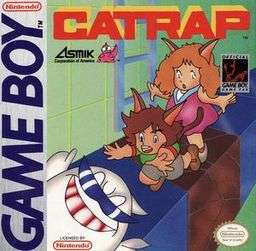Pitman (video game)
| Pitman | |
|---|---|
|
North American cover artwork. | |
| Developer(s) | Asmik |
| Publisher(s) | Asmik |
| Composer(s) | Masao Asakawa |
| Platform(s) | Game Boy, 3DS Virtual Console |
| Release date(s) |
Game Boy 3DS Virtual Console |
| Genre(s) | Puzzle |
| Mode(s) | Single-player |
Pitman, also known as Catrap in the US, is a puzzle-platform video game released by Asmik for the Nintendo Game Boy in 1990, originally developed for the Sharp MZ-700 computer in 1985. The Gameboy version of Pitman was rereleased on the Nintendo 3DS Virtual Console in October 2011. The word 'Catrap' refers to the frequent amount of times the player is trapped and needs to reverse their movements and the two anthropomorphic cats the player must manoeuvre to advance through the levels. The game is credited with having originated the time-rewind mechanic, which later appeared in titles like Blinx: The Time Sweeper, Prince of Persia: The Sands of Time, Braid and Pullblox.[1]
Game mechanics
Pitman is a puzzle game. The player directs the avatar, an anthropomorphic cat, to navigate a room while clearing obstacles and kicking monsters and ghosts off the screen. Once the player has knocked all of the enemies off the screen, they advance to the next level. Advancement grows difficult for the player as increasingly intricate obstacles are presented to complicate the process of overcoming all of the monsters and ghosts. The game encourages trial and error. A player may try one combination of manoeuvres by moving the obstacle in one direction, then they may find themselves trapped. The player can hit the 'A'-button to reverse their movements and try again in a different way until they find the solution that enables them to access all of the enemies and knock them off the screen. Trial and error make up a large portion of the game. Players can also create their own mazes.
Difficulty
There are 100 levels for the player to clear, each one more difficult than the last with more room for error and typically take longer to complete. The first level involves no obstacles with one monster on the opposite side of the screen to knock off; the last level involves a blockade of boulders and a conundrum of ladders for the player to move and navigate to clear several floating ghosts, the most difficult level with the smallest margin for error.
History
The game concept was originally created in 1985 on a MZ-700 home computer by Yutaka Isokawa. The BASIC listing of the game was published in the August 1985 issue of the magazine "Oh!MZ Publications" as type-in program.[2][3] The popularity of the game caused it to be picked up for Game Boy conversion in 1990. In the Game Boy version there is a nod to the MZ-700 version, the layout of round 77 is a big M and Z. In 2004 it was released for I-mode mobile phones as Pitmania and Pitmania 2, with graphics more similar to the original MZ700 game. Pitmania 1 Infinite was released in 2007, which had improved and more colorful graphics. A version was released for the Nintendo 3DS in the 3DS eShop in October 2011.[4] In 2012 the game community restored an faithful as possible Sharp MZ-700 version from the available source code variants.[5]
Reception
The game is credited with having originated the time-rewind mechanic, which later appeared in titles like Blinx: The Time Sweeper, Prince of Persia: The Sands of Time, Braid and Pullblox.[1]
References
- 1 2 Ashley Davis, Why Catrap is the coolest puzzle game you've never played, Destructoid
- ↑ Hardcore Gaming 101, Who created PITMAN? on hardcoregaming101.net (2011)
- ↑ The Untold History of Japanese Game Developers DVD review by Tom Massey on Eurogamer "Pitman creator Yukata Isokawa's emphatic emotional response to receiving a long-lost magazine featuring his original source code is particularly memorable." (2014-09-12)
- ↑ Fletcher, JC (2011-10-13). "NintendoWare Weekly: Catrap, 101-in-1". Joystiq. Retrieved 2011-10-14.
- ↑ The (almost) original version of Pitman (Catrap) preserved (July 19, 2012)
External links
- GameSpot page for Pitman (Catrap)
- Pitman at MobyGames
- Yutaka Isokawa website
- Isokawa's Original HuBasic Source Code scanned from Oh!MZ August 1985
